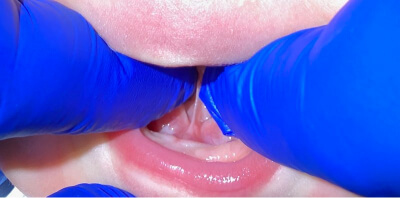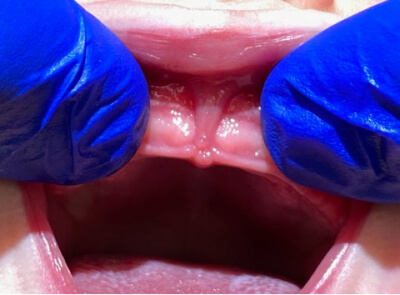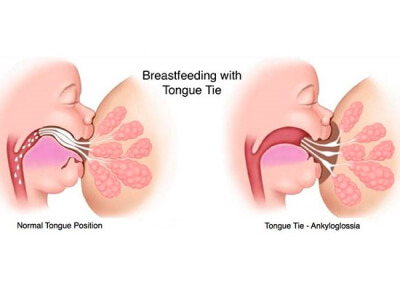What is a tongue tie?

A tongue tie occurs when the thin membrane under the baby’s tongue (the lingual frenulum) restricts the movement of the tongue. All babies are born with some of this tissue, but for approximately 3-15% of newborns, it is so tight that they cannot move their tongues freely. This can affect their ability to breastfeed and lead to poor latch, nipple pain and trauma, decreased milk intake and a decline in milk supply over time. The medical term for tongue tie is “ankyloglossia” and studies show the defect is likely hereditary.
What is a lip tie?

Many babies with a tongue tie, also have an abnormally tight membrane attaching their upper lip to their upper gums (the labial frenulum). This is called a lip tie. Babies with a lip tie often have difficulty flanging their lips properly to feed and can’t create a proper seal at the breast. This can cause them to take in excess air during breastfeeding, which often makes these babies gassy and fussy.
How and why do ties affect breastfeeding?
The mobility of the tongue is very important during breastfeeding, both for the mother and the baby. A baby with a tied tongue may not be able to latch deeply onto the breast, past the nipple onto the areola. This compresses the nipple onto the hard palate in the baby’s mouth, leading to nipple pain and skin breakdown for the mother. A tongue tie often accompanies a high palate, which also decreases the suction and further reduces milk transfer.

Babies with ties may not maintain a latch for long enough to take in a full feeding, while others may remain attached to the breast for long periods of time without taking in enough milk. Some infants will feed only during the mother’s milk ejection reflex, or “let-down” when the milk ejects more freely, but won’t continue to draw milk out of the breast when this slows. Bottle feeding allows milk to drip into the mouth without effort, thus requiring less tongue muscle effort than is needed for breastfeeding.
An infant’s inability to breastfeed often results in the mother giving up breastfeeding entirely, while being told that the problem is her fault. In reality, the problems may actually result from restricted tongue and upper lip attachments – making normal function, mobility and breastfeeding difficult or impossible.
Signs and Symptoms of Tongue and Lip Ties
Some babies with tongue ties and lip ties are able to attach to the breast and suck well. However, many of these infants have breastfeeding problems. The following signs are common amongst infants with tongue and lip ties and their mothers. However, it is important to note that these signs can be linked to other breastfeeding problems and are not solely related to ties.
Infants may exhibit:
- noisy suckling or clicking
- popping on and off the breast
- leaking on the sides of the mouth
- poor weight gain
- coughing or gagging
- lip blisters
- gas pain
- noisy breathing/snoring sounds when sleeping
- reflux or colic symptoms
Mothers may experience:
- flattened nipples after breastfeeding
- nipple pain and damage
- prolonged feedings
- poor breast drainage
- decreased milk production
How are tongue and lip ties diagnosed?
Tongues and lips are only considered to be tied if their movement is restricted, impairing mobility. Correct examination of infants requires the infant be placed on the examiner’s lap with the infant’s head facing the same direction as the person evaluating the infant. It is important to note that not all ties cause problems and require correction. Each case needs to be assessed by an educated and trained practitioner on an individual basis. Tongue tie is a diagnosis based upon function, so what your baby’s tongue looks like can sometimes be less important than how it can move. Dr. Ririe and Dr. Pothier will work with your baby’s International Board Certified Lactation Consultant to determine if a tie is present and if it is affecting the function of the lip or tongue.
Treatment for tongue ties and lip ties

Tie revisions (called frenectomies) remove the tissue or tight frenulum under the tongue or upper lip. Dr. Ririe and Dr. Pothier use a state of the art CO2 laser for a safe and quick procedure that allows for greater tongue and lip mobility. In some instances, frenectomies can aid in the prevention of other health problems like dental decay or spacing, speech difficulties, and digestive issues.
While the procedure can be done with a laser or scissors, advantages of revising ties with a laser include:
- Minimal discomfort
- Minimal bleeding during and after the procedure – the laser aids in hemostasis
- Faster healing
- Bactericidal properties
- Increased precision and complete removal of a tie
Our Team Approach
Dr. Ririe and Dr. Pothier feel that post-revision care is important to the success of the revision. Essentially, the baby must learn how to use his or her tongue in a new way. Some babies need no help at all and immediately breastfeed post-procedure, while other babies may need help by additional professionals. Dr. Pothier and Dr. Ririe have a team of professionals in their referral network that includes International Board Certified Lactation Consultants, CranioSacral therapists, chiropractors, and speech therapists. This team approach helps to ensure the best possible outcome for your baby!
Download post-op instructions